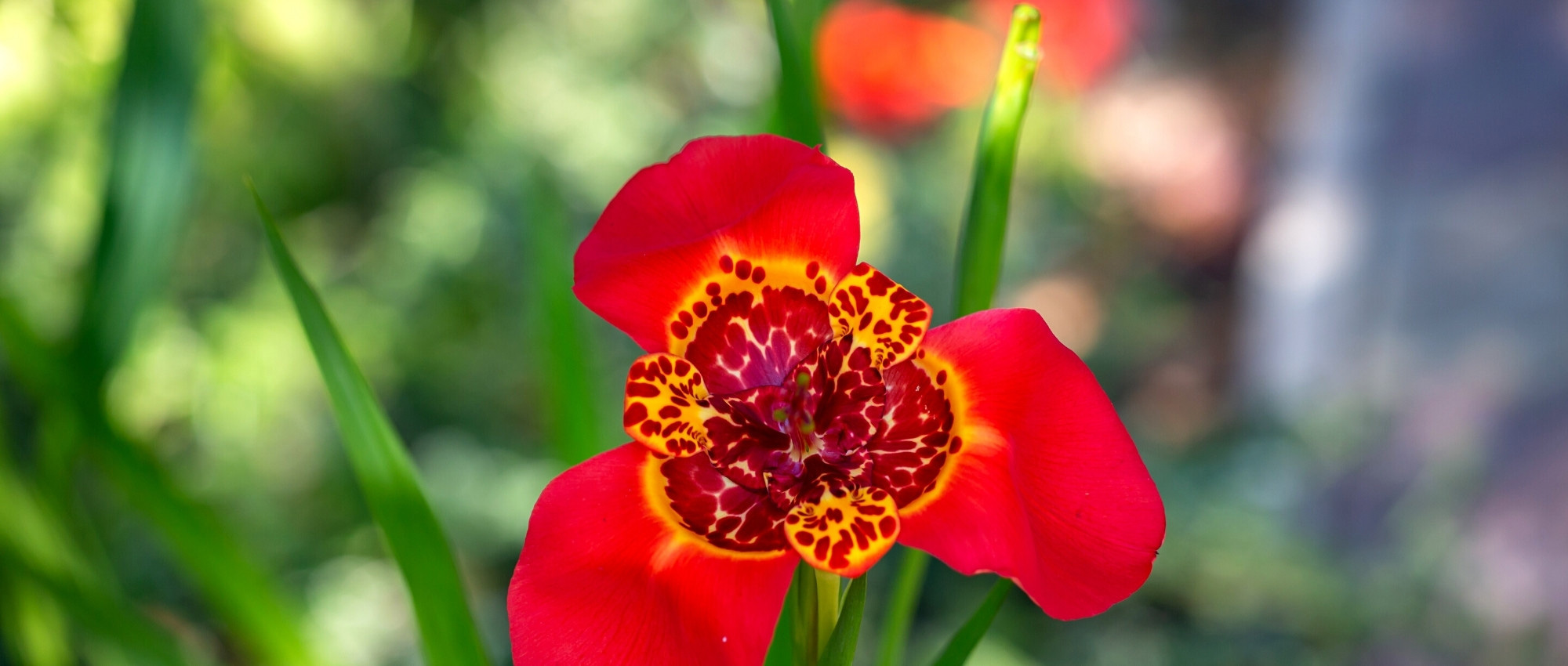
Tigridia: planting, growing and care
Contents
Tigridia in a nutshell
- Tigridia offers triangular and unusual flowers in summer, with a heart speckled in purple
- They have bright and luminous hues, often very colourful: scarlet red, yellow, pink, or white
- Its exotic style is appreciated, perfect for integrating into a jungle garden, a sunny rockery, or a terrace with a tropical vibe
- It thrives in full sun and well-drained soil
- It is not very hardy, but adapts easily to pot cultivation to be brought indoors in winter
The word from our expert
Tigridia, with Tigridia pavonia being its most famous representative, is a beautiful perennial plant with corms, native to Central America, which produces strikingly colourful triangular flowers in summer. These flowers come in a vibrant palette of colours: scarlet red, orange, yellow, white, and pink, adorned with purple spots at the centre of the flower, giving them great intensity and contrast. The Tigridia’s flowers are impossible to miss! They blend perfectly into jungle-style gardens, exotic terraces or balconies, poolside areas, or colourful mixed borders, alongside other summer bulbs.
These plants thrive in warmth: they prefer full sun and a perfectly drained substrate, even if it’s rocky or sandy. Tigridias are tender plants, not very hardy. They can withstand short periods of frost, where temperatures do not drop below -5 °C. Therefore, it is advisable to dig up the corms in autumn to protect them from the cold or plant them in pots so they can be sheltered during winter. Of course, if you live in a region with a very mild climate, such as the Mediterranean basin, where the risk of frost is low, you can safely leave them outdoors in winter.
To create stunning flower beds, Tigridias are best planted in groups rather than in isolation. This will create a beautiful mass effect. You can mix different varieties together. They also pair wonderfully with exotic-style plants like crocosmias, kniphofias, or daylilies, as well as with more common perennials (yarrows, coneflowers, gauras…).
Discover Tigridias and all our tips for successful cultivation: which variety to choose, where and how to plant them, how to propagate them, and how to combine them to create harmonious flower beds!
botany
Botanical data
- Latin name Tigridia pavonia
- Family Iridaceae
- Common name Peacock flower, Tiger flower, Mexican shellflower
- Flowering summer, typically in July-August
- Height 40 to 60 cm
- Exposure sun or partial shade
- Soil type moist, well-drained, rich, and slightly acidic
- Hardiness -5 °C
Tigridia is a perennial cormous plant native to Central America (particularly Mexico and Guatemala). It grows in steppes, rocky areas, and sandy soils. It has also naturalised in Colombia, Bolivia, Peru, and Brazil. There are 53 species of Tigridia, but in cultivation, the most common is the Tigridia pavonia, which comes in various varieties, offering a range of colours and floral patterns.
Tigridia belongs to the iris family, Iridaceae. This large family includes herbaceous plants, usually bulbous or rhizomatous, many of which are prized in gardens for their colourful and sophisticated blooms: among them are irises, crocosmias, gladioli, crocuses, freesias, watsonias, and dietes.
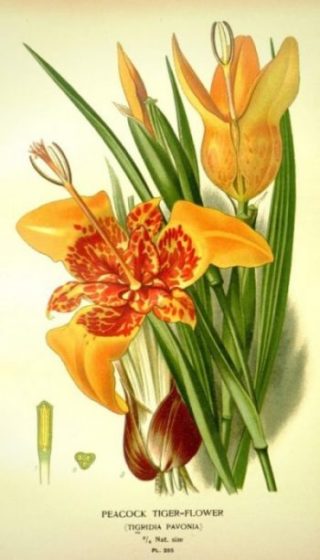
Tigridia pavonia: Botanical illustration
The name Tigridia comes from the Latin tigris, alluding to the tiger-like patterns on the flowers. The Tigridia pavonia owes its species name to the Spanish physician and botanist Joseph Pavon Jimenez, who in the 18th century took part in an expedition to Central and South America and described many native plants. The Pavonia, a plant in the Malvaceae family, was also named in his honour.
Tigridia is a somewhat tender plant, tolerating short-lived frosts down to -5 °C. Therefore, except in the very mild climates of the Mediterranean region, it is best to protect the plant in winter by digging up the corm or, if grown in a pot, bringing the pot indoors.
When grown in our climates, Tigridias typically reach between 40 and 60 cm in height. In their natural habitat or under optimal growing conditions, they become much taller and can reach up to 1.50 m in height.
Tigridia flowers in summer, usually in July-August. The flowers are ephemeral, lasting only a day, opening in the morning and wilting by evening, but they bloom successively over several weeks.
The flowers are triangular and measure 10 to 15 cm in diameter. They consist of three large, well-developed sepals and three smaller, more discreet sepals arranged alternately. At the centre, they bear a long trifid style (divided into three at the tip) and three stamens. The flowers of the species-type (as found in the wild) are red, marked with yellow. There are various varieties offering a wider range of colours: white, yellow, orange, pink… Most often, the throat is speckled with purple, adding intensity to the bloom. There are exceptions: the variety ‘Alba Immaculata’, for example, has entirely white flowers.
Some Tigridia species have very different flowers, shaped like small bells drooping towards the ground: for example, Tigridia meleagris. However, in cultivation, you will mainly find varieties derived from Tigridia pavonia, with their characteristic triangular flowers.

Tigridia flowers come in various colours: red, pink, yellow, white… Tigridia pavonia (species-type), and the varieties derived from it: Tigridia pavonia ‘Lilacea’ (photo M0tty), ‘Canariensis’, and ‘Alba Grandiflora’ (photo Uleli)
Tigridia forms clumps of sword-shaped leaves, slender and measuring 20 to 50 cm long. They are pleated lengthwise and arranged in a fan shape, resembling the foliage of irises. The leaves are mainly basal, but the flowering stems may also bear one to three sheathing leaves, shorter than the basal ones.
Tigridia develops its foliage in spring, flowers in summer, and then the leaves wither in autumn, after which the plant enters dormancy until the following spring. Like most bulbous plants, Tigridia dislikes moisture during its dormancy period, as this can cause the corms to rot.
Tigridia grows from a corm: this is an underground storage organ very similar to true bulbs, but consisting of a swollen underground stem surrounded by a few dried leaves forming a protective sheath (whereas true bulbs are made up of swollen scales, which are modified leaves). They allow the plant to store minerals and survive the harsh season underground, sheltered from the cold, by entering dormancy. Like Tigridia, several other plants in the Iridaceae family produce corms: crocosmias, gladioli, crocuses, freesias…
The fruit of Tigridia is a capsule that splits into three valves at ripeness to release the seeds. In mild climates, it may self-seed in the garden. It is also possible to harvest the seeds for sowing.

The slender, pleated foliage and corms of Tigridia pavonia
The main varieties of Tigridia
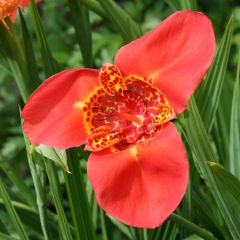
Tigridia pavonia Speciosa
- Flowering time August, September
- Height at maturity 45 cm

Tigridia pavonia Alba
- Flowering time August, September
- Height at maturity 60 cm
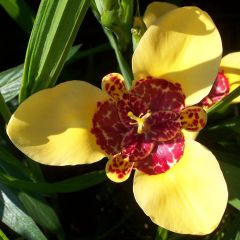
Tigridia pavonia Aurea
- Flowering time July, August
- Height at maturity 45 cm
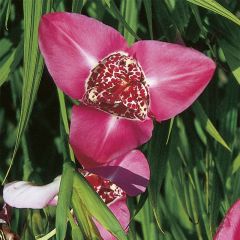
Tigridia pavonia Lilacea
- Flowering time August, September
- Height at maturity 45 cm
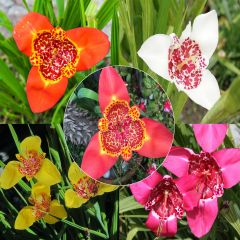
Tigridia pavonia Mix
- Flowering time July, August
- Height at maturity 45 cm
Discover other Tigridia
View all →Available in 1 sizes
Available in 1 sizes
Available in 1 sizes
Available in 1 sizes
Available in 1 sizes
Planting Tigridia
Where to Plant?
The Tigridia is a plant that thrives in warmth: place it preferably in full sun and sheltered from cold winds. However, if you live in areas like the Mediterranean basin, where sunlight is abundant and the climate is particularly mild, opt for a partially shaded spot.
In regions with minimal frost risks, such as the Mediterranean basin, you can plant the Tigridia directly in the ground without issue. In cooler regions, you can either plant it in the ground but will need to dig up the corms in autumn to overwinter them, or plant it in a pot, making it easy to bring indoors for winter.
In the wild, the Tigridia grows in well-draining, rocky, or sandy soils. It dislikes stagnant moisture, especially in winter, and thus requires light, loose, and perfectly drained soil. You can also incorporate it into a sunny rock garden. However, it appreciates fertile soils, preferably rich in humus. Regarding pH, the Tigridia prefers acidic soils and does not tolerate limestone.
For a more striking effect, we recommend planting it in groups rather than in isolation. Ideally, place at least 10 bulbs together. You can choose a mix combining several Tigridia varieties, in different colours.
When to Plant?
The Tigridia is planted in spring, between April and May. You can start the Tigridia earlier by planting it in a pot and initially placing it in a greenhouse or conservatory.
How to Plant?
In the ground:
- Dig a planting hole and loosen the soil to a depth of about 20 cm.
- Feel free to improve drainage by adding coarse sand or gravel, which you’ll mix with the planting soil, along with a bit of well-decomposed compost.
- Place the corms in the hole, positioning them 10 cm deep and spaced 10 to 15 cm apart. Ensure they are oriented correctly, with the pointed end facing upwards.
- Cover them with soil and lightly firm it down.
- Water generously.
In a pot:
- Choose a sufficiently large pot with drainage holes at the bottom. Terracotta pots are a good option as they are aesthetically pleasing and offer excellent water and air permeability, aiding drainage.
- Place a drainage layer at the bottom of the pot (gravel, clay pebbles, broken pottery shards, etc.).
- Add the substrate to the pot. For example, you can mix potting soil with garden soil and coarse sand.
- Place the corms 8-10 cm deep.
- Cover them with substrate.
- Water.
- Position the pot in a sunny spot sheltered from cold winds.
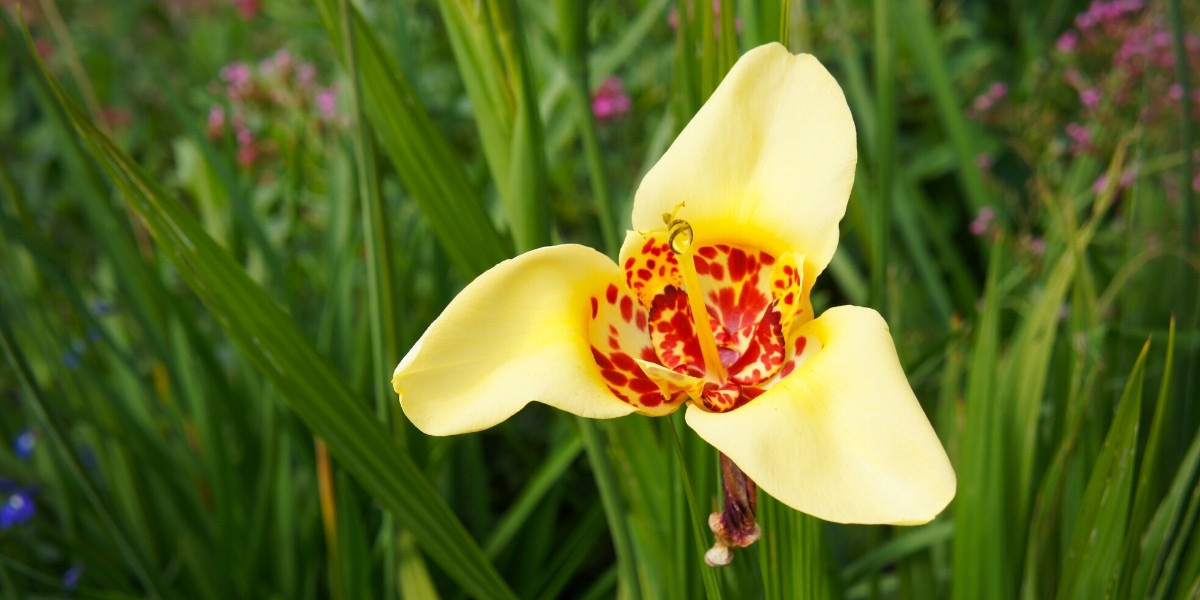
Tigridia pavonia ‘Canariensis’
Maintenance
Tigridia prefers the soil to remain moist during its growing and flowering period. Don’t hesitate to provide regular watering (once or twice a week) in spring and summer. Be vigilant if you’re growing Tigridia in a pot (especially a terracotta one), as the substrate dries out much faster than in the ground! It will therefore need more frequent watering. Preferably use rainwater, as Tigridia dislikes lime. Reduce and then stop watering in autumn and winter, as the plant is dormant and excess moisture could cause the corm to rot.
Don’t worry if, after flowering, you notice the foliage turning yellow and drying out: this is entirely normal. The plant is entering dormancy, storing mineral nutrients in its underground parts (the corm), and will spend the winter underground, re-emerging the following spring. Do not cut the leaves or dig up the corm until the foliage has completely yellowed.
If you’re growing Tigridia in a pot, we recommend repotting it every spring, using a slightly larger pot each time. This allows you to refresh its substrate and give it enough space to develop properly.
Overwintering
In the ground, if you live in a region with a very mild climate where the risk of frost is low, you can leave Tigridia in place. In this case, don’t forget to mark its location with a label, as Tigridia’s foliage dries out after flowering and reappears the following spring. This will prevent you from damaging the corms if you work in the flowerbed.
If you leave it in the ground over winter, don’t hesitate to protect it from the cold with a thick layer of mulch. You can also place a protective cover (such as a transparent sheet) over the bulb to shield it from winter rain and moisture.
In autumn, dig up the corms and store them under cover to protect them from cold and winter moisture. We recommend placing them in dry sand at a temperature of around 10°C. You can replant the corms in spring.
If it’s in a pot, you can easily bring it under cover in autumn and move it back outside in spring.
Diseases and Pests
Occasionally, slugs and snails may nibble on Tigridia’s young leaves in spring. You can protect it by using slug pellets or creating a slug trap. For more advice and information, feel free to consult our guide “Slugs: 7 Effective and Natural Ways to Control Them”. Tigridia is also susceptible to diseases transmitted by sap-sucking insects like aphids. The plant may then show deformities, necrosis, or discolouration. Unfortunately, there is no cure, and affected plants should be removed to prevent the disease from spreading to others.
Multiplication
The simplest and quickest way to propagate Tigridia is by dividing the corms, but it is also possible to sow the seeds, which allows for a larger number of young plants.
Sowing
Sowing is done in spring. In a mild climate and under favourable conditions, Tigridia may self-seed.
- Prepare pots by filling them with special sowing compost. Level the surface and lightly firm it down.
- Sow the seeds by scattering them on the surface.
- Do not cover the seeds, as they need light to germinate.
- Water gently with a fine spray.
- Place the pots under shelter, in a bright spot but out of direct sunlight. The ideal temperature is between 16 and 20 °C.
Ensure the substrate remains slightly moist until germination. Tigridia seeds usually take 2 to 3 weeks to germinate. Once the seedlings are large enough to handle (at least 5 cm tall), you can transplant them into individual pots.
Tigridia plants grown from seed will not flower in the first year, but only from the second or third year onwards.
Division of Clumps
The best time to do this is in late summer or early autumn, when you lift the corms to store them under shelter. We recommend dividing Tigridias every three years to rejuvenate the clumps.
- Carefully dig up the corms, taking care not to damage them.
- Divide them by removing the bulblets that have formed around the original corm.
- Replant them in pots with a well-draining substrate, such as a mix of one-third compost, one-third loam, and one-third coarse sand. They should be planted about 10 cm deep.
- Cover them with substrate and lightly firm it down.
- Water.
Association
Enjoy the vibrant flowering of Tigridia to create an exotic garden. This type of combination is perfect for enhancing the surroundings of a terrace or swimming pool. Pair it with tropical-style blooms in warm colours (yellow, orange, red, purple…). You could choose, for example, crocosmias, kniphofias, daylilies, and cannas. Discover the stunning Belamcanda chinensis, also known as the Leopard Lily, which offers beautiful star-shaped orange flowers speckled with dark red in summer. These will echo the floral patterns of the Tigridia! Surround these blooms with decorative and lush foliage to create a jungle-like atmosphere. Consider, for example, tetrapanax, gunnera, fatsia, banana plant Musa basjoo, giant hostas… Enjoy the colourful foliage of Phormium ‘Pink Panther’, with its brown, red, and copper tones. Also, discover the Schefflera taiwaniana, which is hardy down to –12°C! And to give your garden a true jungle vibe, don’t hesitate to include some climbing plants: bignonias, akebias, passionflowers…
Check out our guide “Exotic Garden: All Our Tips for Designing It”, as well as our inspiration page “Exotic Ambience”.
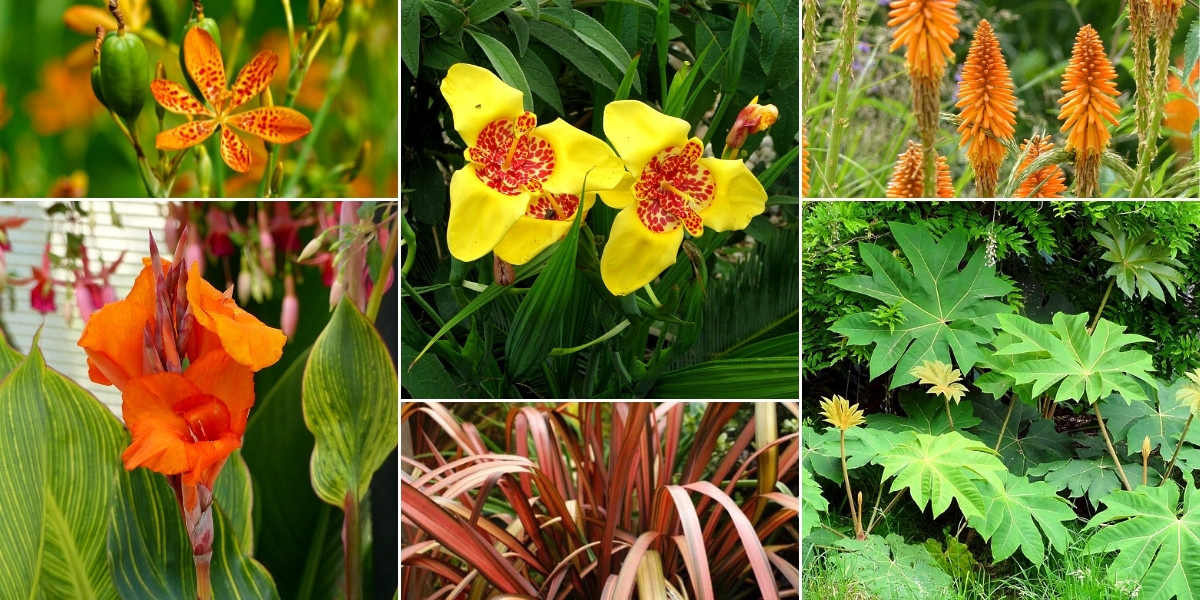
Belamcanda chinensis, Tigridia pavonia ‘Aurea’ (photo peganum), Kniphofia ‘Fiery Fred’, Canna striata, Phormium ‘Pink Panther’, and Tetrapanax papyrifera ‘Rex’
Tigridia is an original and very uncommon plant, and it shines when paired with other rare bulbs, especially those offering giant and exuberant flowers! Discover, for example, the Cardiocrinum giganteum, also known as the Giant Himalayan Lily, which produces large flower spikes bearing 10 to 15 trumpet-shaped flowers, reaching up to 2 metres tall! Also consider the Crinum powellii, the Zantedeschia aethiopica ‘Himalaya’, the Galtonia candicans ‘Moonbeam’, and the giant lily ‘Honeymoon’. Discover the surprising flowering of the Scadoxus multiflorus, with its bright red pom-poms. This will give you a bed with an exotic style, filled with botanical curiosities and uncommon flowers!
For more ideas and advice, check out our guide “7 Rare and Original Bulbs”.
Tigridia can also be incorporated into a more traditional but equally colourful bed, for example with dahlias, coneflowers, yarrows, agastaches, blanket flowers, and sneezeweeds. Also consider ornamental grasses to lighten the bed and add a striking graphic effect: you could include, for example, fountain grasses and feather grasses.
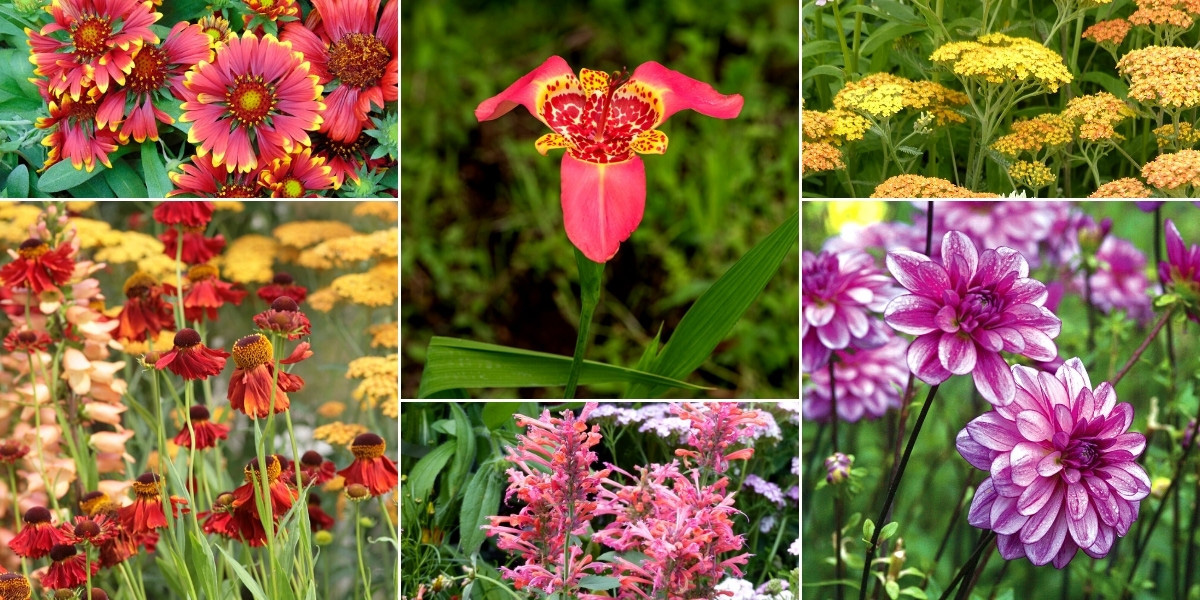
Gaillardia aristata ‘SpinTop Orange Halo’, Tigridia pavonia, Achillea ‘Terracotta’, Helenium ‘Morheim Beauty’ (with Digiplexis ‘Illumination Chelsea Gold’ and Achillea ‘Terracotta’), Agastache ‘Kudos Coral’, and Dahlia ‘Seduction’
→ Discover more ideas for pairing Tigridia in our advice guide!
Also worth reading
- Discover our range of Tigridias
- To pair with Tigridia, explore our range of summer-flowering bulbs, and all our exotic-style plants
- For more pairing ideas, check out our inspiration page “Exotic Atmosphere”
- Subscribe!
- Contents































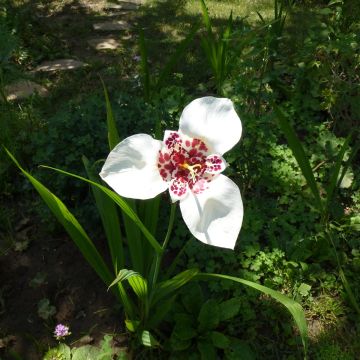




Comments